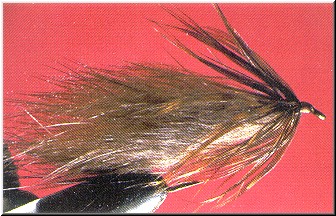The Assom Dragon
By Skip Morris
In Fly Fishing for Smallmouth Bass,
author Harry Murray neatly states the case:
"An artificial dragonfly nymph, fished over a
silty part of the stream with a deliberate darting
action, will produce many fine smallmouth bass."
As for largemouth bass, author Jack Ellis, in
Bassin' with a Fly Rod, speculates
that "Odonata nymphs are probably and important
part of a largemouth's diet." In case you don't
speak entomology, "Odonata" means dragonfly.
The main things you need to know about dragonfly
nymphs are that they live in still or slow-moving
water just about everywhere, that they are big and
corpulent and therefore attractive to bass, and
that they can move very quickly by spurting water
from their abdomen. The things you need to know
about Charlie Brook's Assom Dragon are that it is
an imprecise but effective imitation of a dragon
nymph; that its abdomen is formed by an unusual
but useful tying technique; and that its abdomen
is made of soft fur, which flattens in movement
and swells at a pause - just like the bellowing
abdomen of a real water-spurting dragon nymph.
The original Assom was designed for trout, but
it's very effective for bass. Big pan fish like
it too.
The original had a body of seal's fur on the hide.
Seal's fur is tough to get now, which is probably
just as well. My favorite substitute is rabbit,
and that's what I'll use here. Rabbit fur is longer
than seal, but when handled as I'll describe, it
creates a soft, full body that, when submerged,
mimics the form and movements of a real dragon
nymph's abdomen.
The Morrisform Predator. . .is another approach to
dragon-nymph imitation. I use both flies for
bass - the Assom for edges of a lake or stream
and the Predator for deeper water.
Fish the Assom Dragon however you see fit - in
between the rapid darting and slow clambering of
a real dragon nymph there is lots of range. I
like to fish it around the edges of largemouth
lakes - put it next to cover, let it sink, at
least a bit, then work it back with slow pulses
and occasional quick ones. Whatever the bass
prefer. I have taken small mouths on it too,
but most of my familiar small-mouth-waters are
low on dragons, high on crayfish. Still, Harry
Murray's opinions on smallmouths and dragons are,
doubtless, on the mark.
Materials List The Assom Dragon:
Hook: Heavy wire, 1X or 2X long, sizes 10
to 2. (The hook shown is an Eagle Claw D58F).
Weight: Lead wire (optional).
Thread: Brown 3/0.
Body: a strip of dyed-brown rabbit fur
on the hide.
Hackle: One, grizzly dyed brown.
Instructions - The Assom Dragon:
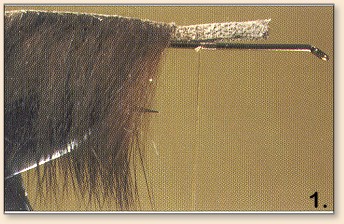
1. Start the thread at about mid-shank. Cut a
thin strip of rabbit hide with fur - the fur should
slope to the side of the strip. Or you can
buy such strips, usually called "crosscut rabbit."
Trim the fur from one end of the strip; the bare
hide should equal the length of about half the shank.
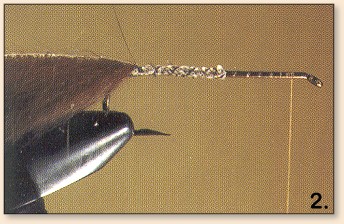
2. Bind the bare end of the strip of rabbit hide
at mid-shank. Bind the strip along the top of the
shank, to the bend. The, with the fur, should
project off the hook's bend. Add a few tight
thread-turns at the bend. The fur should be
atop the hide and should slope towards you,
regardless of whether you tie right or left handed.
(Add lead from the front of the hide up one quarter
of the shank, if you want a weighted fly.)
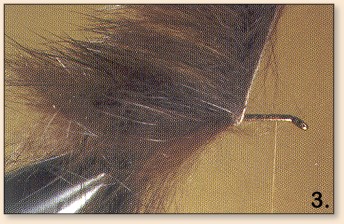
3. Spiral the thread forward to slightly behind
the hook's eye. Wrap the strip up the shank in
close turns, bare side down, fur side up, fur
sloping back. Secure the strip with tight
thread-turns slightly back from the hook's eye.
Trim the strip closely.
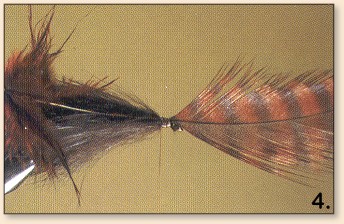
4. Strip the fuzz from the base of a hackle with
long, soft fibers - a rooster-neck, rooster-saddle,
or hen-neck hackle. Bind the hackle's bare stem
just behind the hook's eye so that the hackle
projects off the eye. Wind the thread tightly
back over the stem to the front of the
body. Trim the stem.
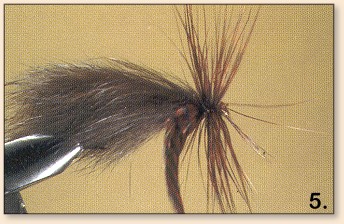
5. Wind the hackle back in a few close
turns to the front of the body. Upon reaching
the body, secure the hackle's tip with a turn
of thread; spiral the thread forward through
the hackle. Brooks preferred that the hackle
fibers curve forward, towards to hook's eye.

6. Trim out the hackle's tip. Draw back the fibers
from the hook's eye using the triangle. Complete the
Assom Dragon with a thread head and head cement.
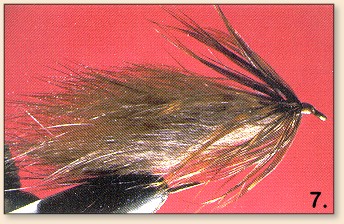
~ SM
Credits:
Excerpt from The Art of Tying the Bass Fly, by
Skip Morris, published by Frank Amato Publications. We
appreciate use permission.
|

